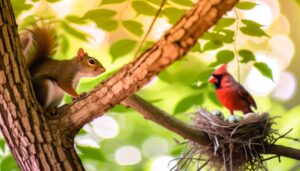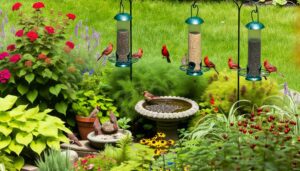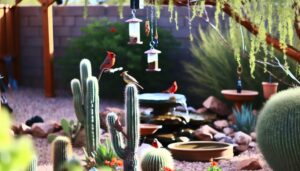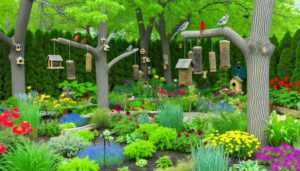7 Simple Steps to Build the Perfect Bird Feeder for Cardinals
To build a bird feeder for cardinals, gather untreated timber, screws, and non-harmful paint. Choose a platform design with an elevated, roof-covered structure.
Precisely saw durable wood pieces, sand them smooth, and assemble the frame using weather-resistant wood and stainless steel screws. Pre-drill and securely attach the roof, sealing edges for waterproofing.
Add perching spots using ¼ inch dowels and apply a weatherproof sealant. Hang the feeder 5-6 feet above ground with sturdy, weather-resistant hardware.
Fill it with cardinal-friendly seeds, ensuring a stable and clean environment. You'll soon create an inviting feeding station rich in detail and utility.
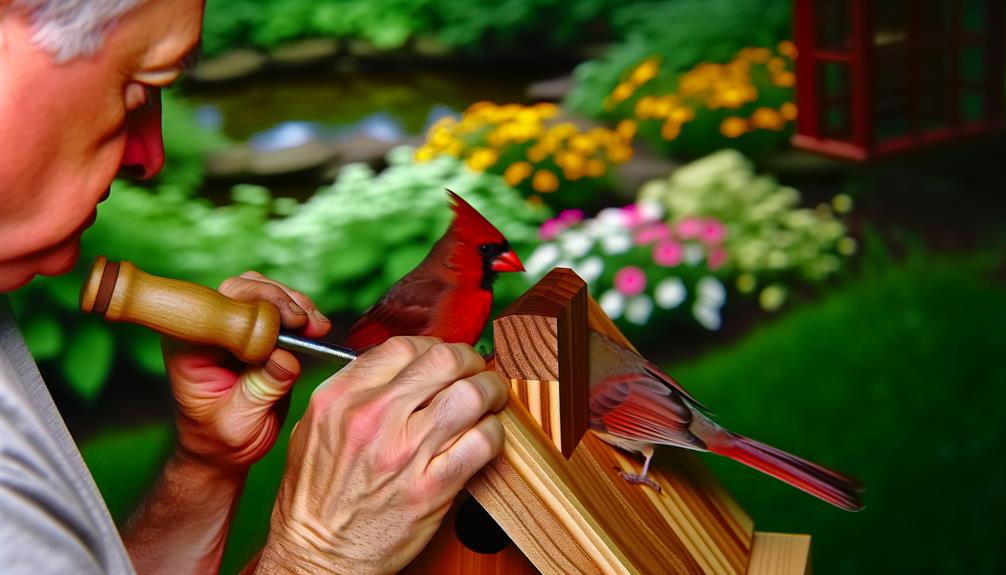
Key Takeaways
- Use untreated, weather-resistant wood to ensure the feeder is safe for cardinals and durable in outdoor conditions.
- Design a platform feeder with a roof to protect the seeds from rain and provide a spacious feeding area for cardinals.
- Elevate the feeder 5-6 feet above ground to prevent predators and ensure cardinals feel safe while feeding.
- Choose seed types such as sunflower seeds that are favored by cardinals and fit well within the feeder design.
- Secure all components with stainless steel screws and apply a non-harmful, weatherproof sealant to protect the feeder from the elements.
Gather Your Materials
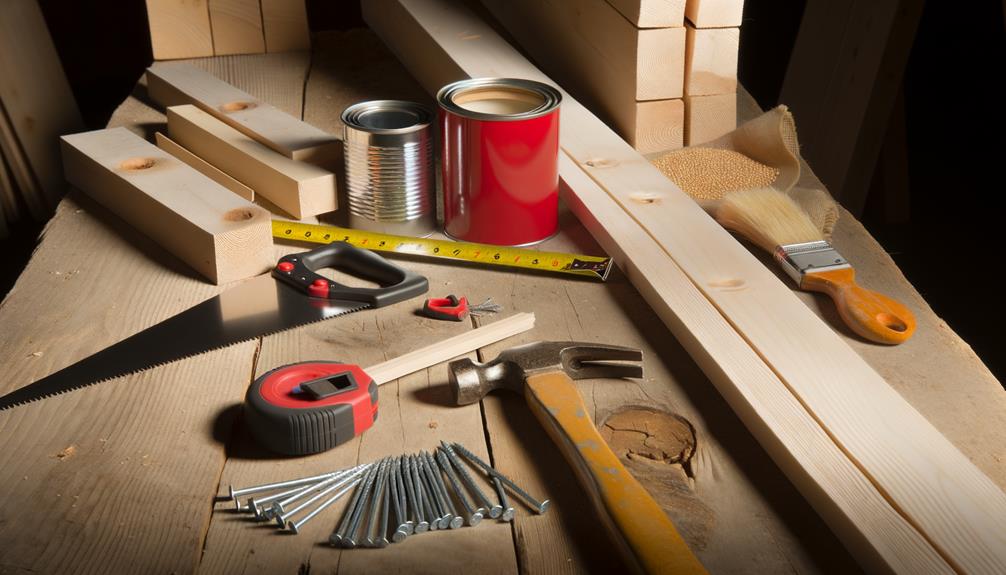
To construct a bird feeder for cardinals, you'll need to gather specific materials like untreated timber, screws, a saw, a power tool, and non-harmful paint. Untreated timber guarantees no harmful substances seep into the food. Select screws that resist corrosion to extend feeder longevity. A saw will assist you in cutting the timber to accurate measurements. Utilize a power tool to make openings for screws, ensuring a robust framework. Non-harmful paint adds a touch of color while safeguarding the birds.
Measure twice, cut once to prevent errors. Each tool and material is crucial for crafting a safe, long-lasting bird feeder that attracts cardinals to your garden, offering them a consistent food source while conserving their natural habitat.
Choose the Right Design
Selecting the right design for your bird feeder is crucial to making sure it meets the specific needs and behaviors of cardinals. Cardinals prefer stable, spacious feeders that accommodate their size and feeding habits.
Here are four key design elements to take into account:
- Platform Feeder: A broad, flat surface allows cardinals to perch comfortably.
- Roof Covering: A sturdy roof protects seeds from rain and snow, making sure they stay dry and appealing.
- Elevated Placement: Position the feeder 5-6 feet off the ground to deter predators and provide a safe feeding environment.
- Seed Type Compatibility: Ensure the feeder can dispense cardinal favorites like sunflower seeds and safflower seeds.
Cut the Wood Pieces
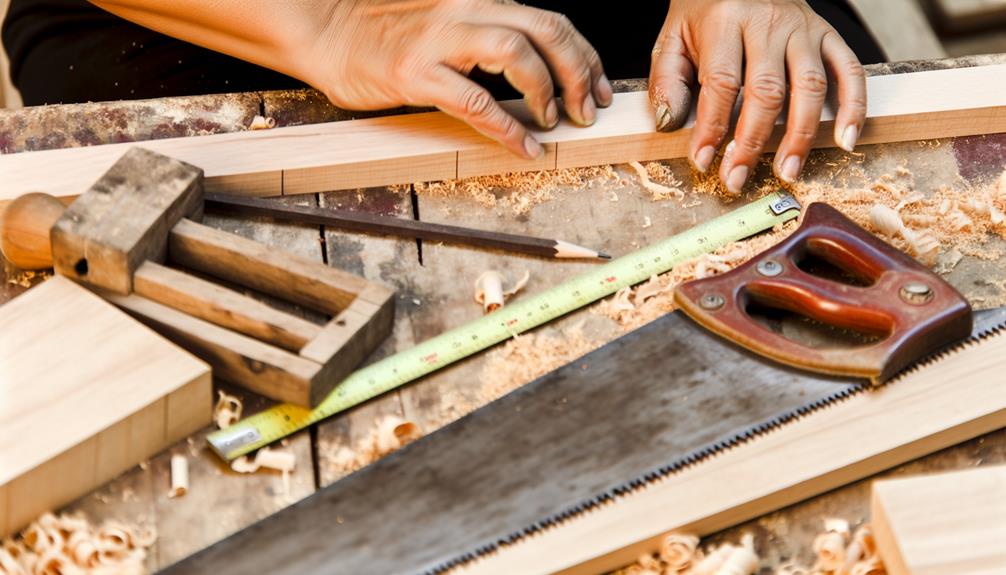
Start by selecting a durable wood type like cedar or redwood, which resists weathering.
Accurately measure and mark the cuts needed for each piece of the feeder to guarantee a precise fit.
Use a saw to cut the wood according to your marked measurements, maintaining clean and straight edges.
Measure and Mark Cuts
Before you begin cutting, carefully measure each piece of wood according to the dimensions specified in your bird feeder plans. Use a reliable measuring tape and a carpenter's pencil to guarantee accuracy.
- Base: Measure the base piece to 12 inches by 8 inches.
- Roof Panels: Mark two roof panels, each measuring 10 inches by 6 inches.
- Side Walls: Measure and mark the side walls, each at 8 inches by 6 inches.
- Front and Back Walls: Mark these pieces to be 12 inches by 8 inches.
Double-check your measurements to avoid errors. Align your marks with a straight edge to ensure precise cuts.
Precision here will save you from complications later, giving you the freedom to build a sturdy, attractive bird feeder.
Select Wood Type
With your measurements marked, it's time to choose a durable and bird-safe wood type, such as cedar or pine, to secure your feeder withstands the elements and provides a safe feeding environment for cardinals.
Cedar is naturally resistant to rot and insects, making it an excellent choice for outdoor use. Pine, while less resistant, is easier to work with and more readily available. Make sure the wood is untreated to avoid exposing birds to harmful chemicals.
Cut each piece according to your marked measurements, using a precise saw for clean edges. Sand the cut pieces to remove any splinters, which could harm the birds.
This attention to detail secures a safe, sturdy, and long-lasting feeder for your feathered visitors.
Assemble the Frame
Now that you've cut the wood pieces, choose sturdy materials like cedar or redwood to guarantee the frame's durability.
Use wood glue and galvanized screws to secure the frame joints for maximum stability.
Make sure each joint aligns perfectly to create a solid structure that can withstand outdoor elements.
Choose Sturdy Materials
To secure your bird feeder can withstand the elements and support the weight of visiting cardinals, select durable materials such as weather-resistant wood, stainless steel screws, and UV-protected plastic. These materials ensure longevity and stability.
Here's a step-by-step list of what you'll need:
- Weather-resistant wood: Opt for cedar or redwood, recognized for their natural resistance to decay and insects.
- Stainless steel screws: These resist rust and provide sturdy joints that won't loosen over time.
- UV-protected plastic: Use this for the feeder's roof to shield the seeds from sun and rain.
- Marine-grade varnish: Apply this to the wood for additional protection against moisture and UV rays.
Secure Frame Joints
Warrant the frame's joints are firmly fastened by aligning each piece of wood precisely and using stainless steel screws to create sturdy connections. Start by measuring and marking where each joint will connect. Pre-drill holes to prevent splitting and confirm a snug fit. Apply wood glue at the joints for added strength before inserting the screws.
Stainless steel screws resist rust, guaranteeing the feeder withstands outdoor conditions. Use clamps to hold pieces in place while securing the screws tightly. Check for stability by gently shaking the frame; it should remain firm without any wobbling.
Precise assembly and durable materials assure your bird feeder will provide a safe and lasting haven for cardinals, letting you enjoy their beauty freely.
Attach the Roof
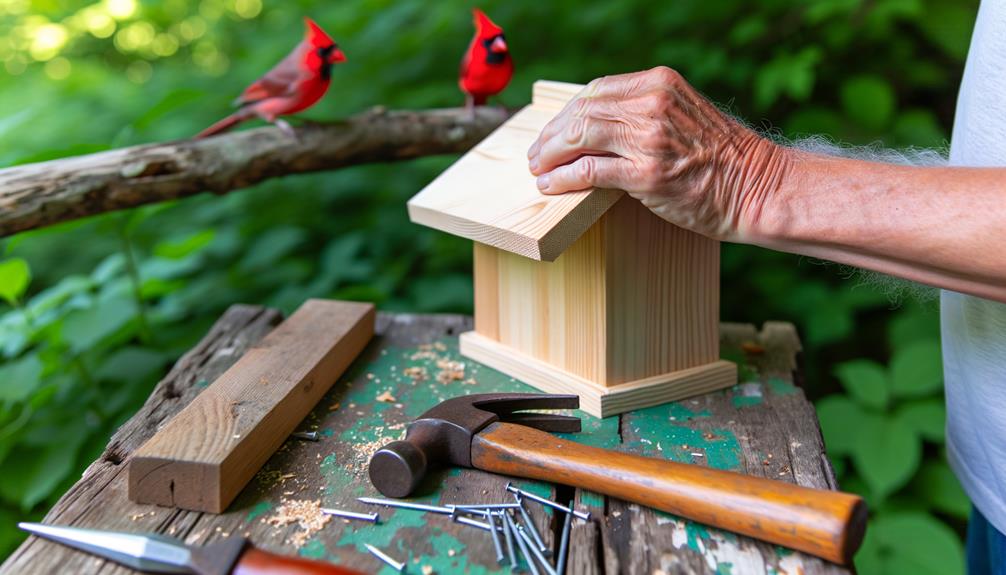
Stabilize the roof to the bird feeder by aligning it carefully with the top edges of the side panels and fastening it with weather-resistant screws.
To ensure a snug fit and best protection from the elements, follow these steps:
- Position the Roof: Place the roof evenly over the feeder's top edges. Verify it covers all sides equally.
- Pre-drill Holes: Mark and pre-drill small pilot holes through the roof and top edges to prevent wood splitting.
- Fasten Screws: Use weather-resistant screws to firmly attach the roof. Tighten them securely but avoid over-tightening.
- Seal Edges: Apply a waterproof sealant along the seams where the roof meets the side panels to prevent water ingress.
These steps offer durability and prolonged usage for your cardinal-friendly bird feeder.
Install the Feeding Tray
With the roof firmly in place, it's time to install the feeding tray to make certain your cardinals have a stable and ample space to feed.
Start by selecting a tray made of durable, weather-resistant material like cedar or metal. Measure the base dimensions, confirming the tray fits snugly. Secure it using galvanized screws to prevent rusting.
Place the tray at least 2 inches below the roof to provide ample headroom for the birds. For efficient drainage, drill small holes at the corners of the tray. This prevents water accumulation and keeps the seed dry.
Verify the tray edges are smooth to avoid harming the birds. Your well-constructed feeding tray will now attract cardinals while ensuring their comfort and safety.
Add Perching Spots
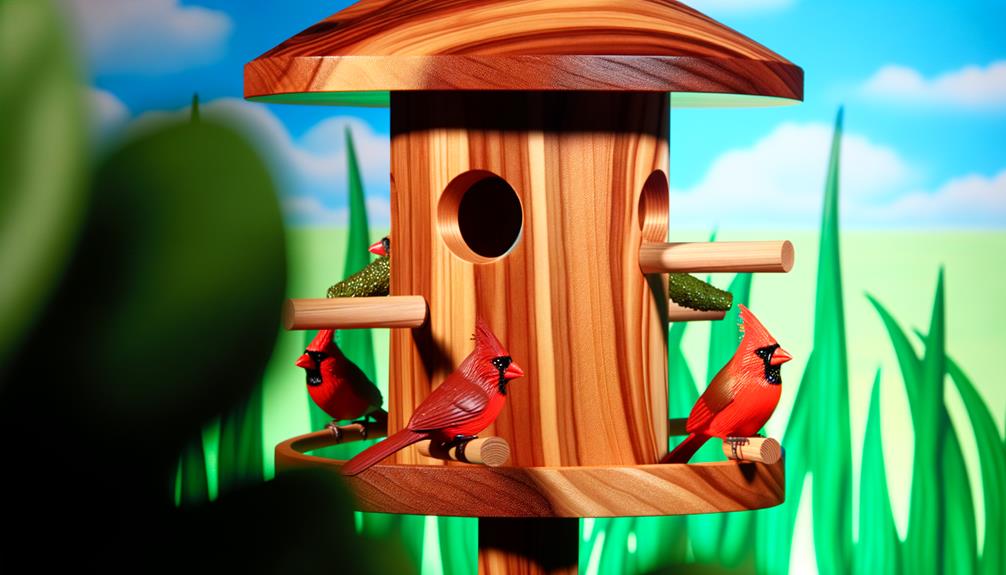
To create ideal perching spots for cardinals, you'll want to use natural branches that blend seamlessly into the environment. Additionally, attaching small dowels can provide extra landing areas.
These perches will help cardinals feel secure and comfortable while they feed.
Use Natural Branches
Incorporating natural branches into your bird feeder design provides cardinals with essential perching spots, enhancing their feeding experience and encouraging frequent visits. These branches mimic their natural habitat, making them feel more comfortable and secure.
To create the best environment, follow these guidelines:
- Select sturdy branches: Choose branches that are thick enough to support the weight of a cardinal but not too bulky.
- Position branches strategically: Place them at different heights and angles around the feeder, simulating a natural setting.
- Ensure stability: Secure the branches firmly to prevent wobbling, which could scare the birds away.
- Keep branches clean: Regularly check for mold or decay to maintain a healthy environment.
Attach Small Dowels
Attaching small dowels to your bird feeder provides additional perching spots, improving accessibility and comfort for cardinals. Choose dowels around ¼ inch in diameter to accommodate their medium-sized feet. Position these dowels strategically, about 2 to 3 inches away from the feeding ports. This setup allows cardinals to easily access seeds while maintaining their balance.
Use a drill to create small holes at the chosen locations on your feeder. Insert the dowels and secure them with a waterproof adhesive to guarantee durability. The added perching spots won't only make feeding more comfortable for cardinals but also minimize competition among birds.
Apply a Protective Finish
Applying a protective finish to your bird feeder guarantees durability and shields it against harsh weather conditions. To achieve best protection, follow these steps:
- Select a Weatherproof Sealant: Choose a sealant specifically designed for outdoor wood. Look for options that resist water, UV rays, and mildew.
- Sand the Surface: Smooth out any rough edges or splinters. This helps the sealant adhere better and provides a sleek finish.
- Apply the Sealant: Use a brush to evenly coat the entire feeder. Apply multiple thin layers, allowing each to dry as per the manufacturer's instructions.
- Inspect for Coverage: Make sure all surfaces, including corners and edges, are well-coated to prevent moisture penetration.
Hang the Feeder
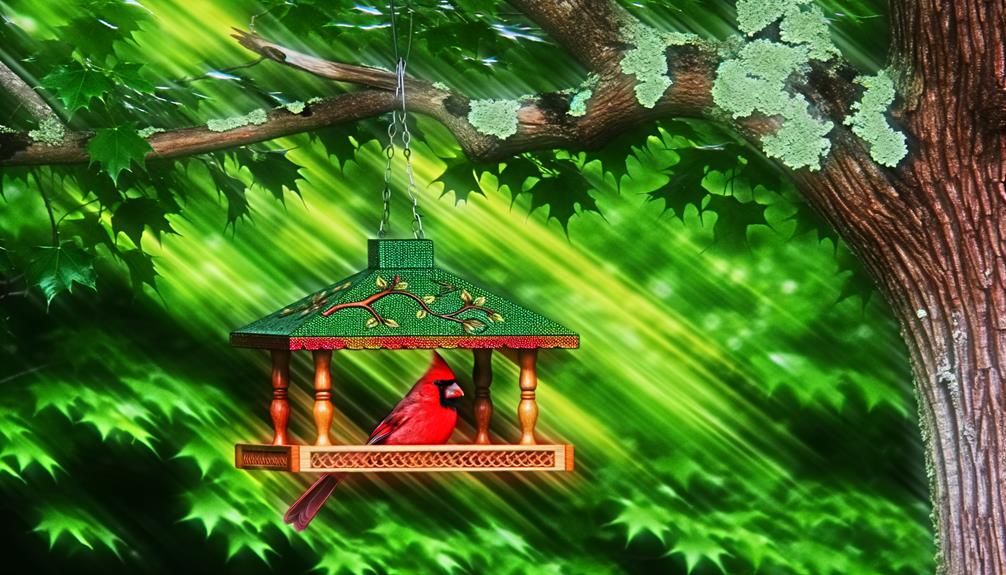
Securing your bird feeder is crucial for providing a safe and accessible feeding spot for cardinals. Choose a sturdy tree branch or a dedicated feeder pole, ideally positioned 5-6 feet above the ground to deter predators.
Utilize weather-resistant hanging hardware, such as stainless steel hooks or nylon cords, to withstand varying conditions. Make sure the feeder is at least 10 feet away from windows to prevent collisions and near shrubs or trees to offer cardinals a quick escape route.
Regularly inspect the hanging mechanism for wear or damage. By firmly hanging your feeder, you create a dependable and safe environment, encouraging cardinals to visit frequently and enjoy their new feeding haven.
Fill With Cardinal-Friendly Seeds
To attract and nourish cardinals, fill your feeder with a mix of sunflower seeds, safflower seeds, and cracked corn, which are particularly favored by these vibrant birds. Cardinals have strong beaks, perfect for cracking open these seeds.
Here's a breakdown of what to include:
- Sunflower seeds: Rich in oil, these seeds provide essential energy.
- Safflower seeds: High in protein, they help with muscle development.
- Cracked corn: Easy to digest and provides necessary carbohydrates.
- Millet: While not a primary choice, it can diversify their diet.
This nutrient-rich blend guarantees cardinals get the energy and nutrition they need. Check that the seeds are fresh and free from mold to keep your feathered visitors healthy and content.
Conclusion
You've successfully built a bird feeder that will delight cardinals and other feathered friends. By following these steps and adding that little extra TLC, your feeder is ready to become the Woodstock of your backyard bird community.
Remember, regular maintenance and refilling with cardinal-friendly seeds guarantee your feathered visitors keep coming back.
Enjoy observing these beautiful birds and contributing to their well-being.
Happy birdwatching!

